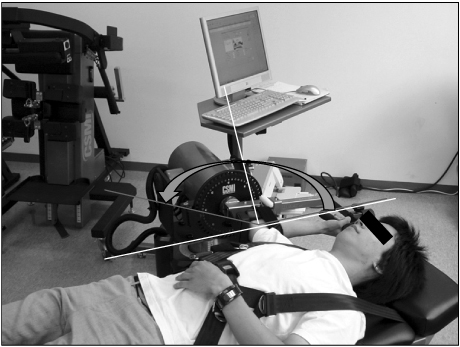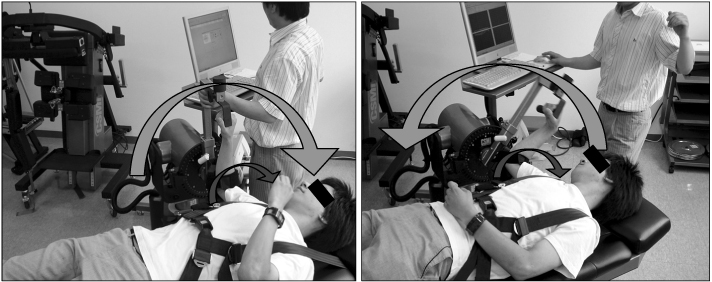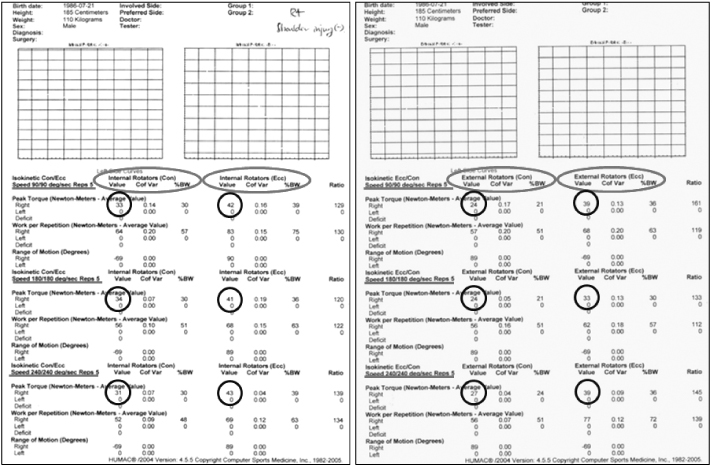Korean J Sports Med.
2012 Dec;30(2):123-129. 10.5763/kjsm.2012.30.2.123.
Isokinetic Measurement of a Concentric and Eccentric Strength of the Rotators in Throwing
- Affiliations
-
- 1Department of Orthopedic Surgery, Gil Medical Center, Gachon University, Incheon, Korea. wonsu07@gilhospital.com
- 2Department of Physical Therapy, Gachon University of Medicine and Science, Incheon, Korea.
- KMID: 2288602
- DOI: http://doi.org/10.5763/kjsm.2012.30.2.123
Abstract
- The shoulder injury was resulted from muscle imbalance between acceleration and deceleration during the throwing. The agonist-antagonist muscle strength relationship for throwing was formerly described as functional ratios of eccentric external rotator to concentric internal rotator moments and eccentric internal rotator to concentric external rotator moments. The purpose of this study was to measure the ratio of concentric and eccentric strength of the shoulder rotators by isokinetic muscle performance in Korean throwing college athletes for descriptive data. On 10 dominant shoulders of asymptomatic throwing college athletes applying Cybex II isokinetic dynamometer, concentric and eccentric muscle strength of the rotators were measured at the speed of 90degrees/s, 180degrees/s, 240degrees/s. Maximal torque ratio of the eccentric strength of the external rotator against the concentric strength of the internal rotator was 1.25, 1.13, 1.21 at the each speed. The functional external eccentric-to-internal concentric ratio was similar with previous published studies. There was no significant difference between each speed. Eccentric strength of the external rotator was higher than concentric strength of the internal rotator during internal and external rotation at all speeds. This functional assessment of strength testing that reflected the importance of eccentric external rotation strength for the dynamic shoulder joint stability during the throwing. Therefore, the increase of the eccentric strength of the external rotator would be helpful to prevent the shoulder injury and to treat for rehabilitation of injured shoulder.
Keyword
MeSH Terms
Figure
Reference
-
1. Alderink GJ, Kuck DJ. lsokinetic Shoulder Strength of High School and College-Aged Pitchers*. J Orthop Sports Phys Ther. 1986. 7:163–172.2. Brown LP, Niehues SL, Harrah A, Yavorsky P, Hirshman HP. Upper extremity range of motion and isokinetic strength of the internal and external shoulder rotators in major league baseball players. Am J Sports Med. 1988. 16:577–585.3. Codine P, Bernard PL, Pocholle M, Benaim C, Brun V. Influence of sports discipline on shoulder rotator cuff balance. Med Sci Sports Exerc. 1997. 29:1400–1405.4. Cook EE, Gray VL, Savinar-Nogue E, Medeiros J. Shoulder antagonistic strength ratios: a comparison between college-level baseball pitchers and nonpitchers. J Orthop Sports Phys Ther. 1987. 8:451–461.5. Ellenbecker TS. A total arm strength isokinetic profile of highly skilled tennis players. Isokinet Exerc Sci. 1991. 1:9–21.6. Ellenbecker TS, Mattalino AJ. Concentric isokinetic shoulder internal and external rotation strength in professional baseball pitchers. J Orthop Sports Phys Ther. 1997. 25:323–328.7. Hinton RY. Isokinetic evaluation of shoulder rotational strength in high school baseball pitchers. Am J Sports Med. 1988. 16:274–279.8. Perrin DH, Robertson RJ, Ray RL. Bilateral lsokinetic peak torque, torque acceleration energy, power, and work relationships in athletes and nonathletes. J Orthop Sports Phys Ther. 1987. 9:184–189.9. Wilk KE, Andrews JR, Arrigo CA, Keirns MA, Erber DJ. The strength characteristics of internal and external rotator muscles in professional baseball pitchers. Am J Sports Med. 1993. 21:61–66.10. Scoville CR, Arciero RA, Taylor DC, Stoneman PD. End range eccentric antagonist/concentric agonist strength ratios: a new perspective in shoulder strength assessment. J Orthop Sports Phys Ther. 1997. 25:203–207.11. David G, Magarey ME, Jones MA, Dvir Z, Turker KS, Sharpe M. EMG and strength correlates of selected shoulder muscles during rotations of the glenohumeral joint. Clin Biomech (Bristol, Avon). 2000. 15:95–102.12. Sirota SC, Malanga GA, Eischen JJ, Laskowski ER. An eccentric- and concentric-strength profile of shoulder external and internal rotator muscles in professional baseball pitchers. Am J Sports Med. 1997. 25:59–64.13. Noffal GJ. Isokinetic eccentric-to-concentric strength ratios of the shoulder rotator muscles in throwers and nonthrowers. Am J Sports Med. 2003. 31:537–541.14. Dale RB, Kovaleski JE, Ogletree T, Heitman RJ, Norrell PM. The effects of repetitive overhead throwing on shoulder rotator isokinetic work-fatigue. N Am J Sports Phys Ther. 2007. 2:74–80.15. Mikesky AE, Edwards JE, Wigglesworth JK, Kunkel S. Eccentric and concentric strength of the shoulder and arm musculature in collegiate baseball pitchers. Am J Sports Med. 1995. 23:638–642.16. Walmsley RP, Szybbo C. A comparative study of the torque generated by the shoulder internal and external rotator muscles in different positions and at varying speeds. J Orthop Sports Phys Ther. 1987. 9:217–222.17. Altchek DW, Hatch JD. Rotator cuff injuries in overhead athletes. Oper Tech in Orthop. 2001. 11:2–8.18. Wang HK, Cochrane T. Mobility impairment, muscle imbalance, muscle weakness, scapular asymmetry and shoulder injury in elite volleyball athletes. J Sports Med Phys Fitness. 2001. 41:403–410.19. Bak K, Magnusson SP. Shoulder strength and range of motion in symptomatic and pain-free elite swimmers. Am J Sports Med. 1997. 25:454–459.20. Dillman CJ, Fleisig GS, Andrews JR. Biomechanics of pitching with emphasis upon shoulder kinematics. J Orthop Sports Phys Ther. 1993. 18:402–408.21. Escamilla RF, Fleisig GS, Barrentine SW, Zheng N, Andrews JR. Kinematic comparisons of throwing different types of baseball pitches. J Appl Biomech. 1998. 14:1–23.22. Escamilla RF, Fleisig GS, Zheng N, Barrentine SW, Andrews JR. Kinematic comparisons of 1996 Olympic baseball pitchers. J Sports Sci. 2001. 19:665–676.23. Feltner M, Dapena J. Dynamics of the shoulder and elbow joints of the throwing arm during a baseball pitch. Int J Sport Biomech. 1986. 2:235–259.24. Fleisig G, Escamilla RF, Andrews JR, Matsuo T, Satterwhite Y, Barrentine SW. Kinematic and kinetic comparison between baseball pitching and football passing. J Appl Biomech. 1996. 12:207–224.25. Moncrief SA, Lau JD, Gale JR, Scott SA. Effect of rotator cuff exercise on humeral rotation torque in healthy individuals. J Strength Cond Res. 2002. 16:262–270.26. Treiber FA, Lott J, Duncan J, Slavens G, Davis H. Effects of Theraband and lightweight dumbbell training on shoulder rotation torque and serve performance in college tennis players. Am J Sports Med. 1998. 26:510–515.27. Heiderscheit BC, McLean KP, Davies GJ. The effects of isokinetic vs. plyometric training on the shoulder internal rotators. J Orthop Sports Phys Ther. 1996. 23:125–133.28. Carter AB, Kaminski TW, Douex AT Jr, Knight CA, Richards JG. Effects of high volume upper extremity plyometric training on throwing velocity and functional strength ratios of the shoulder rotators in collegiate baseball players. J Strength Cond Res. 2007. 21:208–215.
- Full Text Links
- Actions
-
Cited
- CITED
-
- Close
- Share
- Similar articles
-
- Concentric and Eccentric Isokinetic Trunk Muscle Evaluation in Chronic Low Back Pain
- A Comparative Study of Eccentric and Concentric Isokinetic Exercise Testing
- Torque Curves and Heart Rate Responses to Isometric, Eccentric and Concentric Isokinetic Exercises of the Knee and Elbow Joints
- Comparison of eccentric and concentric isokinetic exercise testing after anterior cruciate ligament reconstruction
- Meaurement of the Muscle Fatigue Patterns using Electromyography Technique





